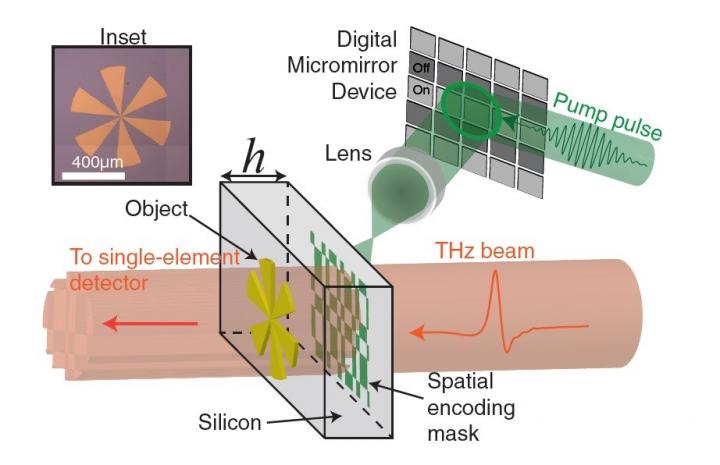
Subwavelength THz Could Improve Image Resolution, Accelerate Imaging Speed
EXETER, England, Sept. 5, 2017 — A terahertz (THz) imaging technique has been developed that is compatible with adaptive and compressive sensing algorithms. The technique was used to demonstrate image reconstruction at subwavelength dimensions, and could potentially allow three-times-faster image acquisition than conventional technologies.
Using a near-field approach, researchers at the University of Exeter achieved a spatial resolution of about nine microns (μm). To remove restrictions on spatial resolution caused by the diffraction limit, they developed a novel setup to measure near-field interactions between THz waves and the object being imaged.

To enable high-resolution terahertz imaging, the researchers used a digital micromirror device to project laser light onto a silicon wafer in a specific pattern. When a terahertz beam passes through the wafer, a computer can reconstruct an image of the object based on the pattern of terahertz light detected. The inset shows an optical image of the test target (gold pinwheel) on a 6-mm-thick silicon wafer. Courtesy of Rayko Stantchev, University of Exeter.
The team used a digital micromirror device (DMD) to project a pattern of 800-nm light onto a silicon wafer. In areas where the light hit the wafer, the wafer became opaque to THz waves. When the THz wave passed through the wafer, it created a patterned beam on the other side that could interact with the object being imaged.
Because the pattern created by the DMD was known, a computer could be used to reconstruct an image of the object placed on the exit interface of the wafer, based on the detected THz light. An implicit assumption was that the transmission through each pattern depended only on the open area and not on aperture shape. Results demonstrated that this assumption proved robust down to a scale of 1/45 of the wavelength used for imaging.
A single-element detector was used to measure the electric field amplitude of transmitted THz radiation for each projected pattern, with the ultrathin wafer allowing the team to access the THz near-fields to achieve a spatial resolution of about nine μm.
To increase imaging speed, researchers designed their approach to be compatible with compressed sensing and adaptive sampling algorithms that could increase the rate of imaging. The algorithms work similarly to image compression, which reduces the size of an image by getting rid of any data not needed to visually perceive an image. Compressed sensing and adaptive imaging algorithms take this a step further by ignoring the unnecessary data to begin with, speeding up imaging by measuring only the vital components of the image.
“We used these algorithms to determine which regions of the wafer are transparent and which regions are not transparent, essentially creating pixels,” said researcher Rayko Stantchev. “Because we were using a single-pixel terahertz detector, normally each pixel would acquire one measurement. However, by creating many transparent pixels in one measurement, an image can be acquired more quickly by taking fewer measurements than the number of pixels.”
The researchers used their setup to image a variety of objects and demonstrated that their method could distinguish arms of a metallic cartwheel that were spaced about nine microns apart.
Such an approach could be used for improving signal to noise in other near-field and low-signal imaging techniques. High-resolution THz imaging at accelerated speeds could potentially enable earlier detection of skin cancers without a skin biopsy.
“Skin cancer can already be detected using terahertz light, but because of the low resolution of current imaging approaches, the cancer can only be seen after it has grown quite large,” said Stantchev.
“Ideally, we want to detect the cancer early, when it is still small. We hope that high-resolution terahertz images, combined with the ability to take an image quickly, could eventually lead to a device that could detect cancer in the doctor's office.”
The team is now working with researchers at the Chinese University of Hong Kong who have created a different optical setup that could make the silicon wafers opaque using a less powerful laser. The teams are working together to see if this approach could make it possible to acquire subwavelength terahertz images using a laser that costs around $200 instead of the almost $400,000 laser used for the work done by the Exeter team.
“For our current setup, we have to use a very intense laser to make the silicon wafers opaque,”said Stantchev. “This laser is very big and expensive, so to make this approach practical, we needed to figure out how to do it using a much cheaper and smaller laser.
“This is one step toward making the technique more compatible with biological applications,” he said. “Eventually, we envision a device that could be used in the doctor’s office that would quickly reveal if skin cancer is present.”
The research was published in Optica, a publication of The Optical Society (doi: 10.1364/OPTICA.4.000989).
Published: September 2017